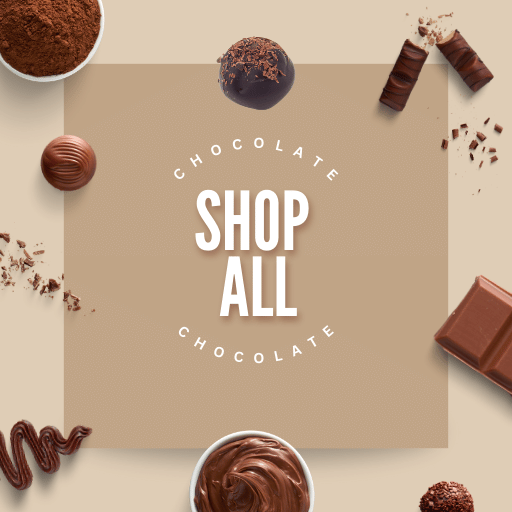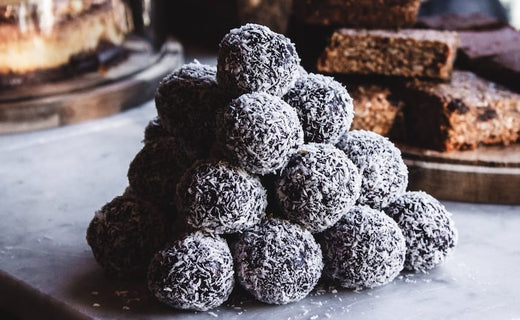You may have come across the terms 'cooking chocolate' and 'normal chocolate' and wondered what the difference is.
Whether you're a budding home baker or just a curious chocolate lover, understanding these differences can significantly impact the final result of your baking and cooking.
So, whether you're planning to whip up a batch of scrumptious brownies or simply enjoy a chocolate bar straight out of the wrapper, join us on this delicious exploration to enhance your understanding and appreciation of the versatile world of chocolate.
Let's embark on this sweet journey!
The Difference Between Cooking Chocolate And Normal Chocolate
Cooking chocolate and normal (eating) chocolate differ primarily in their quality, sugar content, and intended use.
Cooking chocolate, also known as baking or unsweetened chocolate, is usually of lower quality.
It contains less cocoa butter and more cocoa solids and has no or minimal added sugar.
It is designed to melt easily and blend into batters and doughs, making it ideal for baking and cooking.
Normal chocolate, often called eating or table chocolate, is what you'd typically snack on or use in a chocolate bar.
It has more cocoa butter and added sugar for a smoother, sweeter taste.
Its higher sugar content can sometimes cause it to behave differently when melted or baked.
The choice between the two largely depends on the recipe and personal preference.
Some chefs prefer to use high-quality eating chocolate in their recipes for a richer flavour, while others stick to cooking chocolate for its consistent results in baking.

Related Post: How Much Theobromine Is There In Chocolate?
What is Cooking Chocolate?
Cooking chocolate, also known as baking chocolate, is a type of chocolate specifically made for baking and cooking.
It is often available in different forms, such as blocks, chips, or powder.
There are several varieties of cooking chocolate, including unsweetened, bittersweet, semi-sweet, and sweet, differentiated by the amount of sugar they contain:
-
Unsweetened Chocolate: This is pure chocolate liquor, made from ground cocoa beans. It contains no added sugar and has a strong, bitter taste. It's typically used in recipes where sugar is added separately.
-
Bittersweet and Semi-Sweet Chocolate: These types contain some sugar, but not as much as sweet or typical eating chocolate. The exact amount can vary between brands, but bittersweet chocolate usually contains less sugar than semi-sweet.
-
Sweet Cooking Chocolate: This has more sugar than the other types and is closer to the chocolate you'd eat as a snack, though it's still formulated for baking.
Cooking chocolate has a higher proportion of cocoa solids for a robust chocolate flavour and is designed to melt smoothly and integrate easily into recipes.
It's a staple in many desserts, from cakes and brownies to mousses and ganache.
However, due to its minimal or absent sugar content, most cooking chocolate isn't typically enjoyed alone.

Related Post: How Much Fat Is There In Chocolate?
Can You Use Normal Chocolate for Cooking and Baking?
You can use normal chocolate for cooking and baking.
While cooking chocolate is explicitly formulated for culinary applications, many recipes can benefit from the richness and quality of normal or eating chocolate.
Eating chocolate often contains more cocoa butter than cooking chocolate, resulting in a smoother and richer flavour that can elevate your baked goods.
It also typically contains more sugar, which can sweeten your dishes without additional sugar.
However, it's essential to be mindful of the sugar content when substituting normal chocolate for cooking chocolate.
Because eating chocolate is sweeter, you may need to adjust the sugar in your recipe to ensure the end product isn't overly sweet.
Also, remember that different types of chocolate (dark, milk, or white) will behave differently when melted or baked due to their varying cocoa solids and fat contents.
For best results, follow the type of chocolate specified in your recipe or experiment with minor adjustments until you reach your desired outcome.
All in all, while cooking chocolate is a safe choice for consistency in baking, using normal chocolate can offer an extra touch of indulgence to your homemade treats.
Related Post: What Is Theobromine?
Can You Eat Cooking Chocolate Just as a Snack?
While nothing is stopping you from eating cooking chocolate as a snack, it might not provide the experience you're anticipating.
Cooking chocolate, particularly the unsweetened variety, is designed for baking and cooking.
It's typically much less sweet than regular chocolate, containing no added sugar. Therefore, it has a strong, bitter taste that most people find unpalatable.
However, semi-sweet or sweet cooking chocolate might be more enjoyable to snack on, as they contain some sugar but are still not as sweet as regular eating chocolate.
In summary, while you can eat cooking chocolate, eating straight from the packet is generally less enjoyable than normal eating chocolate.
However, everyone's tastes are different, and you might find you enjoy the less sweet, more intense flavour of cooking chocolate.
It all comes down to personal preference.
Related: Can You Eat Cooking Chocolate Without Cooking It?
Where Can You Buy Delicious Chocolate for Cooking and Baking?
The best type of chocolate for cooking and baking largely depends on the recipe you’re following and your personal taste preferences.
However, here are some general guidelines for different types of chocolate:
-
Dark Chocolate: With its robust, rich flavour, it is a versatile choice for many recipes. It’s available in different cocoa percentages, allowing you to choose based on how intense you want the chocolate flavour to be. It’s excellent for ganaches and any recipe with a desired deep chocolate flavour.
-
Semi-Sweet and Bittersweet Chocolate: These are types of dark chocolate, often used interchangeably in recipes. Due to their balanced sweetness and cocoa flavour, they're great for baking, ideal for cookies, brownies, and many other desserts.
-
Milk Chocolate: Sweeter and creamier than dark chocolate, milk chocolate is best used in recipes with a milder, sweeter chocolate flavour. It’s great for making chocolate sauces, fillings, or for use in desserts where its sweetness complements other ingredients.
-
White Chocolate: Although it doesn’t contain cocoa solids, it brings a creamy, sweet, and slightly vanilla flavour to dishes. It can be used in baking, though it’s more sensitive to heat than other types of chocolate.
-
Couverture Chocolate (like Whitakers Easymelt product): This is a high-quality chocolate with a higher percentage of cocoa butter. Due to its smooth texture and shiny finish when melted and cooled, it's excellent for tempering and making chocolate decorations.
-
Cocoa Powder: Cocoa powder is a staple in many baking recipes. It is ideal for adding a chocolatey flavour to cakes, biscuits, and frostings. It provides a strong, bitter chocolate flavour without adding any fat or sweetness.
Remember, the quality matters when it comes to cooking and baking with chocolate.
Higher-quality chocolate will generally produce better results, so it’s worth investing in good chocolate, especially for recipes where chocolate is the star.
Some Notes From an Expert Chocolatier
Having spent many years working with Whitakers Chocolates, a reputable British chocolatier with decades of experience under its belt, I've had the privilege of witnessing firsthand the magical transformation of cocoa beans into the sweet treats we all adore.
As an expert chocolatier, I deal with chocolate all day, every day, and I firmly believe that both normal and cooking chocolate have their rightful places in baking.
In my opinion, using normal chocolate in your baking can be a delightful choice if you're looking for an indulgent, somewhat naughty option.
Normal chocolate is usually higher in sugar and boasts more intense, nuanced flavours due to a higher cocoa butter content.
However, remember that baking is indeed a fine art.
Replacing cooking chocolate with normal chocolate may require you to adjust your recipe and baking technique to accommodate the higher sugar and fat content.
For those who favour precision in their culinary creations, adhering strictly to the recipe and using the recommended cooking chocolate can ensure consistency and minimise room for error.
After all, each type of chocolate brings its unique properties and behaviours to the process, and the results can vary widely if substitutions are not managed carefully.
I'm thrilled to share that Whitakers Chocolates has recently launched a product explicitly designed for baking and melting, born from years of chocolate expertise.
Our new product, Easymelt, is a game-changer for home bakers and professional chefs.
Easymelt uses dark chocolate with a high cocoa percentage, 55%, to be precise, which ensures a rich, decadent flavour.
It's pre-tempered, saving you from the often tricky tempering process at home and ensuring perfect results in baking, flavouring, melting, and decorating.
Moreover, it comes in a resealable package, so you can use it multiple times while preserving its freshness.
As with all Whitakers products, quality and inclusivity are at the heart of Easymelt.
It's gluten-free and vegan-friendly, making it an excellent choice for bakers catering to various dietary needs.
In the end, whether you opt for normal or cooking chocolate in your baking endeavours is a matter of personal preference and the specific demands of your recipe.
But with products like Easymelt on hand, having dedicated, high-quality cooking chocolate is certainly a sweet option to have!
Final Notes On The Difference Between Cooking Chocolate And Normal Chocolate
Understanding the difference between cooking chocolate and normal chocolate can significantly enhance your baking creations and your overall appreciation of this delightful ingredient.
Cooking chocolate also referred to as baking or unsweetened chocolate, is specially designed for use in cooking and baking.
It's typically lower in cocoa butter and higher in cocoa solids than normal chocolate and has minimal or no added sugar.
This makes it ideal for integrating into various recipes, providing a robust chocolate flavour and melting smoothly into batters and doughs.
On the other hand, normal or eating chocolate is intended for direct consumption.
It boasts a higher cocoa butter content and added sugar, making it smoother and sweeter.
Despite its primary role as a snack, normal chocolate can still be used in baking, often imparting a richer flavour to your baked goods.
In essence, while cooking chocolate ensures consistent results in baking, using normal chocolate can lend an extra layer of indulgence to your treats.
The key lies in understanding their distinct properties and choosing the right one for your needs.












1 comment
Exactly what I wanted to know, thank you. Normal chocolate on profiteroles I think !